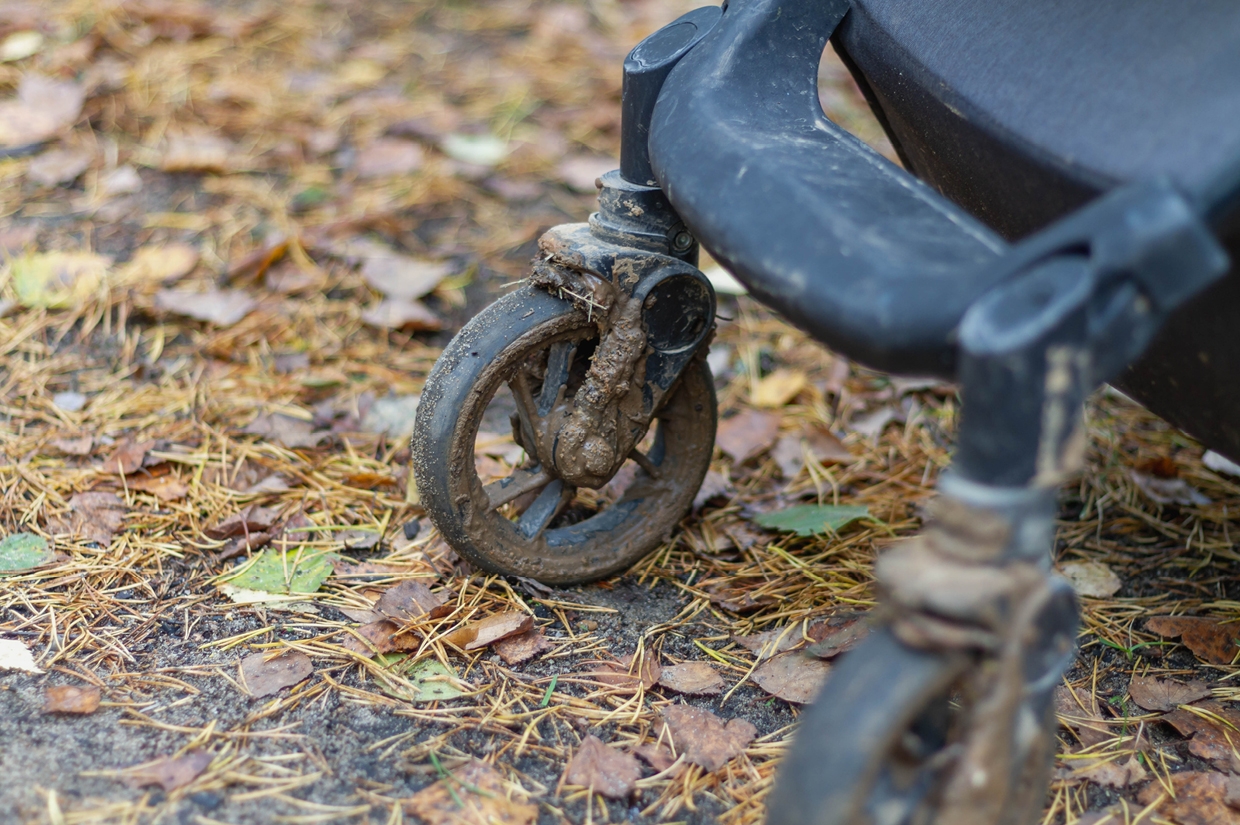How to clean a pram

Is your pram looking a bit sad? Life happens—spit-ups, muddy days, and squashed banana are regular occurrences in a day as a parent with young children. So, to bring your pram back to showroom condition (or as close to as you feel like doing), it needs to be properly cleaned. Find out how often you should clean your pram, how to deep clean it, and how to prevent stains and damages so that it’s always fresh and clean for your little one.
How to clean a pram
Just like a car, prams should be cleaned regularly. Dirt and debris can look bad, but it can also hide damage, and potentially even cause damage if it works its way into moving parts. Given the frequency many parents use their pram, reducing wear and tear can extend the life of the pram and save money in the long run.
If you’re wondering how often you should clean a pram, the answer isn’t an exact science. In a perfect world, giving your pram a good clean once a month is a good idea. However, it’s hard enough keeping up with everything else in life. To keep your pram clean, aim to clean simple messes as they happen, and aim to give it a deep clean every 6 months or so depending on how you use your pram. If you are regularly going on outdoor excursions such as going to the beach or off-road walks, you’ll likely want to up that frequency. Even simply wiping it down occasionally with a wet cloth is a good habit to get into.
Step-by step guide for cleaning a pram:
Read the manufacturer’s instructions
Every pram is different, so before you take it apart to clean, read the manufacturer’s instructions. Most prams include basic care instructions for the specific model and fabric. Knowing how to properly remove pram components will make cleaning and putting the pram back together easier.
Washing the pram seat
Once you’ve read the instructions, it’s time to start cleaning. If you have an additional pram liner, that’s a great place to start. Many pram liners can be machine-washed on a delicate setting, or hand washed and laid flat to dry. Check the cleaning instructions on your liner, remove and wash it, and put your liner out to dry so it can be drying while you clean the rest of your pram.
Clean a pram hood & plastic accessories
Check the manufacturer’s instructions for specific cleaning recommendations for your pram model. Some prams allow you to remove the hood from the pram frame – if yours does, remove and lay it flat before vacuuming any debris. With a soft sponge, give the hood and plastic accessories a good wash with soapy water before you rinse the pram off. Make sure to air dry thoroughly before replacing the parts.
For difficult stains, continue reading to learn how to get rid of stubborn stains or mould during a deep clean.
Vacuum and dust the seat and frame
Crumbs—and sultanas, and entire biscuits, and toys from 6 months ago—can find the smallest places to hide in a pram. Remove large debris, then use a vacuum or a soft-bristled brush to remove any dirt or crumbs from the seat and frame. Using a smaller vacuum head will help you clean all the hard-to-reach places on a pram, especially any moving parts or joints.
Clean the pram chassis
When you’re cleaning your pram’s frame, the last thing you want to do is scuff or damage the metal with abrasive materials. Check your pram manufacturer’s guidelines; most will recommend using warm water and mild detergent to clean your pram. Soak a cleaning cloth in the solution and apply the solution to affected areas. You can then polish the parts with small, circular movements. Your pram will look good as new before you know it. Dry all parts thoroughly before reassembling.
Always inspect all safety features before using
Once your pram is clean, dry and ready to use, make sure to double check all the moving parts of your pram. Inspect the locking devices, brakes, catches, harness, and any joints to ensure your child’s safety. You will want your pram to be able to move freely and in working order.
Basic pram maintenance
Moving parts of your pram such as the wheels and brakes may need some lubrication – cleaning your pram is a great opportunity to lubricate those parts, as well as doing a general check on screws, accessories, and your pram basket to look for damage or wear and tear.
How to deep clean a pram
Outside of your regular cleanings, a pram should also be deep cleaned a couple times a year. While it may feel like a lot of work, thorough cleaning will help you find any dirt, crumbs or stains that don’t get caught in regular cleaning. Also as part of the deep cleaning process, you can get rid of any mould or stubborn stains that you aren’t able to get out during regular cleans. These tasks should be done in addition to regular cleaning tasks, so set some time aside, put on some music with your favourite tunes and grab your rubber gloves.
Cleaning the wheels
The wheels on a pram are the first thing to touch dirt, sand, or grass. To make sure the wheels continue to roll freely, you will need to include them in your cleaning routine. Remove the wheels from the pram to get started and use a soft-bristled brush to clean out any dirt. Use warm soap to wash them and pat them dry before reattaching them to the frame. Once they’re clean, inspect the wheels for damage before placing them back on the pram.
Removing mould from a pram
Mould can be challenging to deal with: it’s difficult to know whether spores are removed or killed, and many solutions may not work on fabric, or may affect the colour or finish of a pram. Preventing mould by storing your pram in a well-ventilated area, ensuring to never fold it away while damp, and airing it in the sun regularly is the best approach. But if mould has already gotten to your pram and you want to try to salvage it, there are a few options you can try, including vinegar, bi-carb, and tea-tree solutions. Importantly, these solutions may result in staining or stripping of colour in pram fabrics. If in doubt about trying to remove mould from your pram, contact the manufacturer for advice tailored to your model.
For the vinegar mix, pour one part of undiluted vinegar into a spray bottle with one part of warm water. For the baking soda mix, add a spoonful of baking soda into a spray bottle and shake until it dissolves with warm water. For both mixtures, spray or rub your solution onto the affected spot and wait an hour. Scrub and rinse off to remove the mould. If you’re trying tea-tree oil, try mixing a teaspoon of oil with about a cup of water and dab onto the affected areas.
For really stubborn mould or stains, follow a ratio of two-parts baking soda, one-part vinegar and one-part water to make a paste. Spread the paste onto the area with the mould. An old toothbrush can be used to spread it and agitate the area before you wipe down with a wet cloth.
Depending on the type of mould, it may not be possible to remove mould completely and you may have to purchase a new pram.
How to steam clean a pram
Steaming a pram is an effective way to deep clean and sanitise it. The steam can reach places that a vacuum can’t to remove dirt and bacteria. Before beginning, check the manufacturer’s instructions and begin removing accessories from the pram, such as the hood, seat pad, and footmuff. Then you can begin steaming the frame and accessories you removed. Once done, allow the pram to air dry before reassembling it.
When deep cleaning your pram, watch out for a few areas that might get looked over as you clean. It’s important that all these areas are well maintained since they could impact your little one’s safety if they fall out of disrepair from not getting properly cleaned.
- Belly bar sockets.
- Canopy connectors.
- The seat recline mechanism.
- The safety harness buckle.
- The folding joints.
- Front and rear wheel hubs.
How to prevent stains and damage to your pram
Preventing stains and damage on a pram is important when it comes to pram maintenance. At the end of the day, it’s easier to prevent stains and damage than fix it or buy a new pram. Spending a few extra minutes when packing up or packing down for the day can save you time and money in the long run.
Tips for preventing stains and damage:
- Use a pram cover or rain cover to protect your pram from rain and other elements.
- Clean spills as soon as they happen.
- Use a pram liner to protect the seat from spills.
- Keep your pram stored in a dry and shaded area.
- Avoid overloading your pram with heavy items to avoid damaging the frame.
- Follow the manufacturer’s instructions for cleaning and maintenance.
A dirty pram can lead to a number of problems, so it’s best to stay on top of regular and deep cleans to avoid long-term messes. Discover a vast range of prams, pram accessories, and more from Baby Bunting now.


